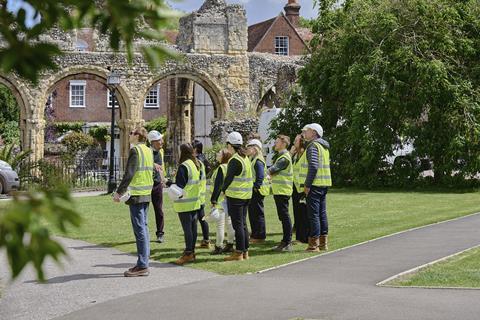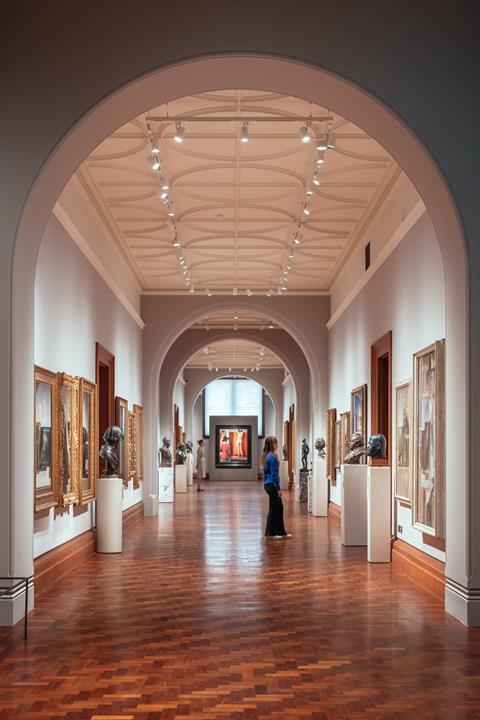Liz Smith explains why Grade III Listing is the right conversation, but not the right solution

The concept of a new ‘Grade III’ listing was publicly introduced by Will Arnold, from the Institute of Structural Engineers. The aim is to save significant amounts of carbon by legislating to make reuse – rather than demolition – the default option throughout our industry. Picked up widely across the press and supported by TV personality Kevin McCloud, this debate has breached its typically esoteric commentary and brought national attention to the subject.
This proposal would give every existing building a mandatory Grade III listing, starting with those of a net internal area of more than 1,000m2. Proposals for replacing an existing structure would need permission to demolish, first proving there is no viable retrofit solution.
This is absolutely the right conversation to be having and I fully endorse Will Arnold for raising it. But for me, it is the wrong solution.
There is a clear argument for implementing a ‘retrofit first’ approach, but we should not conflate the need to save carbon with a system designed to protect buildings of special architectural or historic significance. In practical terms, the knock-on effect of adding thousands of applications to the planning process would be catastrophic for our industry. As reported in a recent article in BD, architects are already reporting a significant increase in projects being cancelled because of delays in the planning process, according to the latest RIBA Future Trends survey.
Moreover, I believe that the heritage policies assist in highlighting the bigger issues of protecting and understanding our cultural heritage, and our continuing history. It is essential that we understand where we have been to understand who we are.
Protection is the enabler to this, by requiring us to understand the significance of the heritage we are working with. If we muddle this with carbon, there is a real danger that we will erode our understanding of our cultural past in preference to understanding only our material past.
Our relationship with the built environment has followed a pattern of 20th century consumerism
There are countless examples of heritage buildings that bring value to communities far beyond the sum of their materials. We are currently working as heritage advisors on plans for Otterpool Park, a new Garden Town in Kent. High importance has been given to protecting and retaining the assets, such as the medieval barns, WWII facilities and a Roman villa within the masterplan site, precisely because these ingredients add distinctive character and identity that is rooted in local history.
It’s a paradox that the architecture most often valued by the public is least valued by those teaching our future architects. Very little is taught in architecture schools in the UK about the conservation and retention of existing buildings and this needs to change.
Our relationship with the built environment has followed a pattern of 20th century consumerism which facilitates a belief that new things are better than old things, and once we throw them away, they somehow disappear without a trace. It’s a fallacy to imagine that a building pulled down can be erased any more than a plastic bag disappears when we put it in the dustbin.
But there are ways to change this mindset and lessons we can learn from the existing systems that protect heritage buildings. Training in traditional techniques and learning about the nature of materials is a fundamental component of our approach at Purcell.

It is why I set up our Conservation School in 2016, which we run in-house each year. It is about passing on knowledge learned through working with heritage buildings and ensuring this valuable information is handed on. It is also about standing up to a disposable culture that frequently disregards what happened in the past.
We should discourage both the term and practice of ‘demolition’ in place of ‘deconstruction’, acknowledging that any non-biodegradable materials from a building at the end of its life must either be reused, taken to landfill or burnt for energy. Burning materials needs serious regulation to prevent unscrupulous developers from burning 100% of their waste and claiming they have diverted it from landfill.
We should also stop imagining that the past is a lesser place than the present when it comes to architectural innovation. Just because we can do something with a material, doesn’t mean we should. Innovation isn’t always about starting from scratch.
It is a far greater test of creativity to look at what already exists and explore how to make it relevant for the present than to pull it down, start again and justify it by claiming that the new building will be more efficient than the old.

In a collaboration with Jamie Fobert Architects, Purcell has recently completed a transformation of the National Portrait Gallery. The new scheme has unshuttered dark spaces, turning the entrance of the gallery to face the city, reclaiming back-of-house areas to create modern galleries with controllable natural lighting, big enough to let the artworks breathe, light enough to keep new generations of viewers engaged.
All this had to be achieved within the constraints of listed building consents and budget. It was a highly creative process, but it involves placing the building at the centre of the design process, not the ego of the architect.
Not every building can have the ambition of the National Portrait Gallery, and the challenge is to use design as a tool to find innovative and creative ways of retaining what already exists for buildings of all scales and functions. With this comes a need to upskill people in retrofitting buildings.
The current skills gap and the potential uplift in the UK’s economy was reported in March this year by Grosvenor in collaboration with The Crown Estate and the National Trust: Heritage and Carbon: Addressing the Skills Gap.
We need help from legislation that makes developers accountable for carbon
As a mechanism, the listed building system clearly works. It is overseen by Historic England, a body of highly regarded experts in their field. Logic follows that we now need a similar body of experts in the impact and legacy of materials and the circular economy, who can advise local authorities when reviewing demolition applications.
There have been many calls to abolish VAT on retrofit developments, in line with new build schemes. More could be done at government level to create a clearer national strategy to prioritise reuse over new build. A planning policy is required that puts the onus on developers to demonstrate that all opportunities for reuse of an existing building have been explored.
The argument from those who want to demolish a building and start again is that a new structure will be more operationally carbon efficient over the building’s lifespan than retrofitting the existing one. The challenge must be to make retrofitted buildings as efficient as any proposed new build.
We have thousands of buildings in this country that have survived for hundreds of years. Purcell’s restoration of Newcastle Cathedral provided an opportunity to replace inefficient lighting and heating systems with energy efficient LED lightbulbs and underfloor heating connected to an air source heat pump.
It was the first Grade I listed cathedral to make this progressive step, and we hope others will now see this as a viable solution. Nobody would dream of pulling down a 1000-year-old cathedral and building a new one because it’s simpler to make it energy efficient, so there is no option but to work together as an industry to find these solutions.
We need help from legislation that makes developers accountable for carbon and this needs to be maintained at national level by funded experts who can advise impartially. What we don’t need is to conflate the individual value in our heritage with a one-size-fits-all carbon reduction programme.
We need accountability to ensure the highest quality and standards for retrofit so that it doesn’t become simply a process of enhancing building performance. Any new system must be the agent of good design to create more liveable communities through an understanding of our built environment context.
>> Also read: Architects blame creaking planning system as project cancellations rise
Postscript
Liz Smith is chairperson of Purcell and the regional partner for London and the South East
















2 Readers' comments